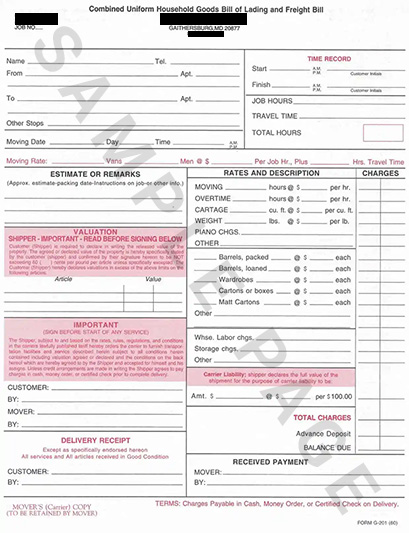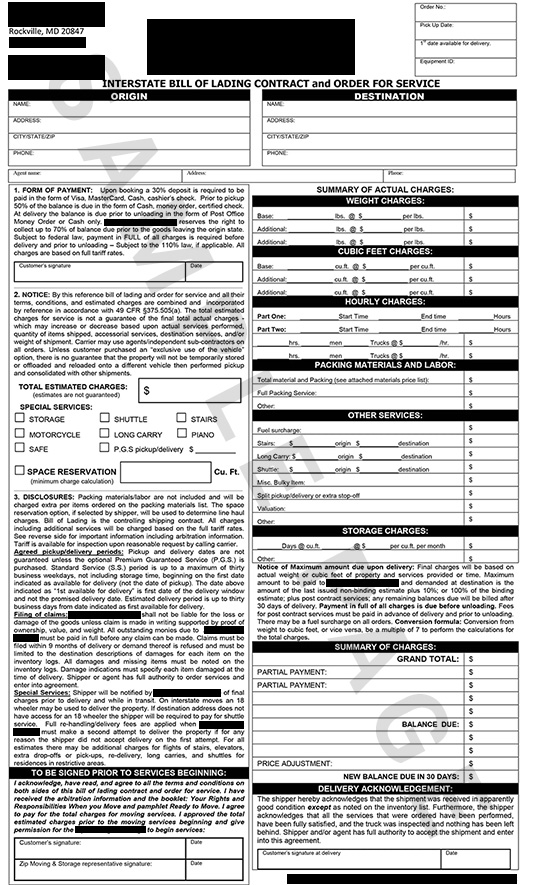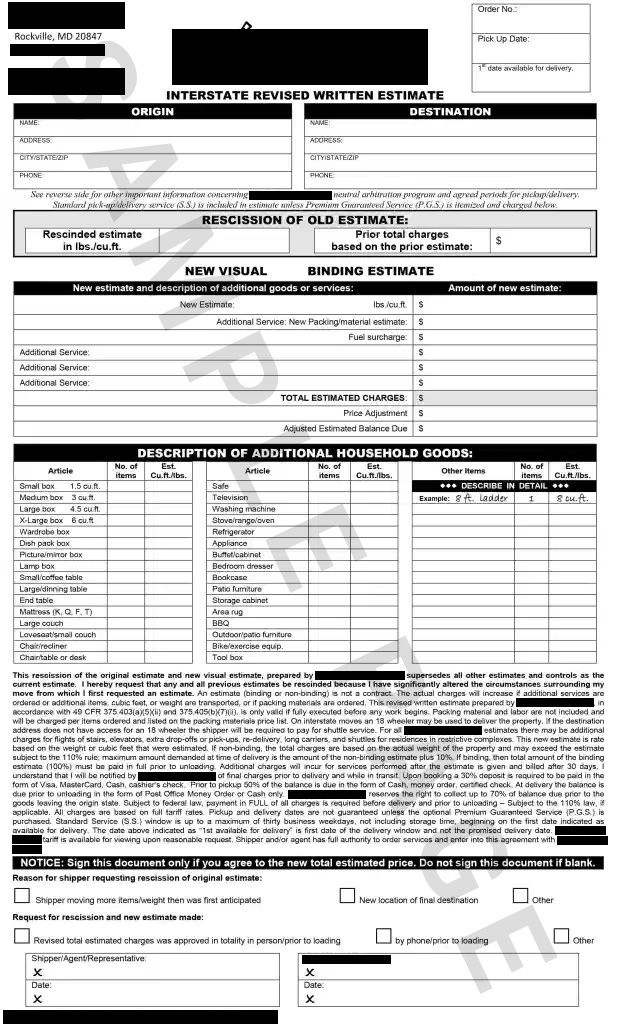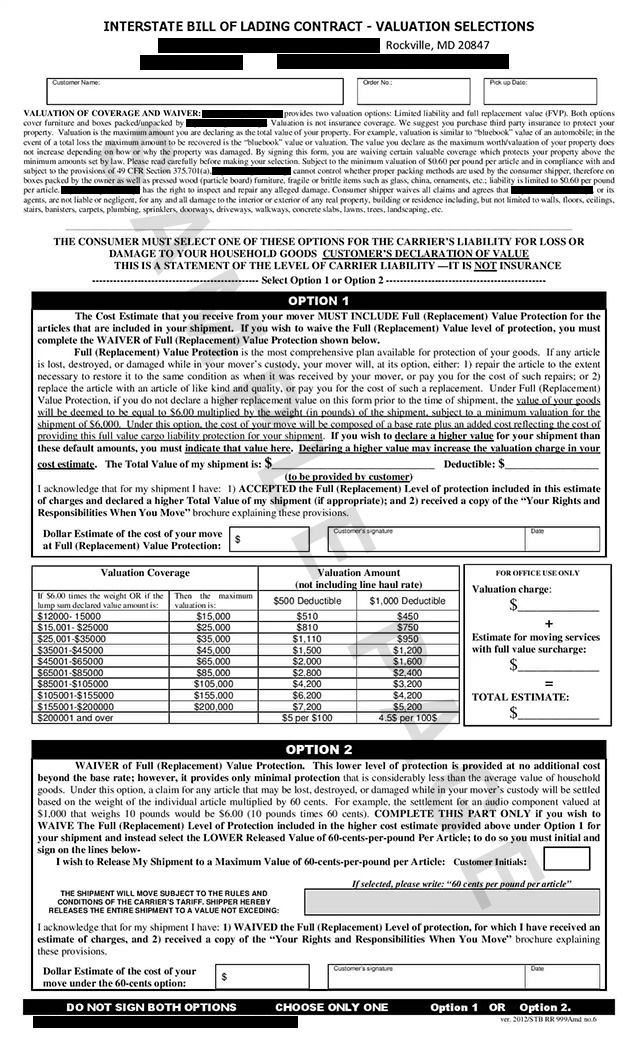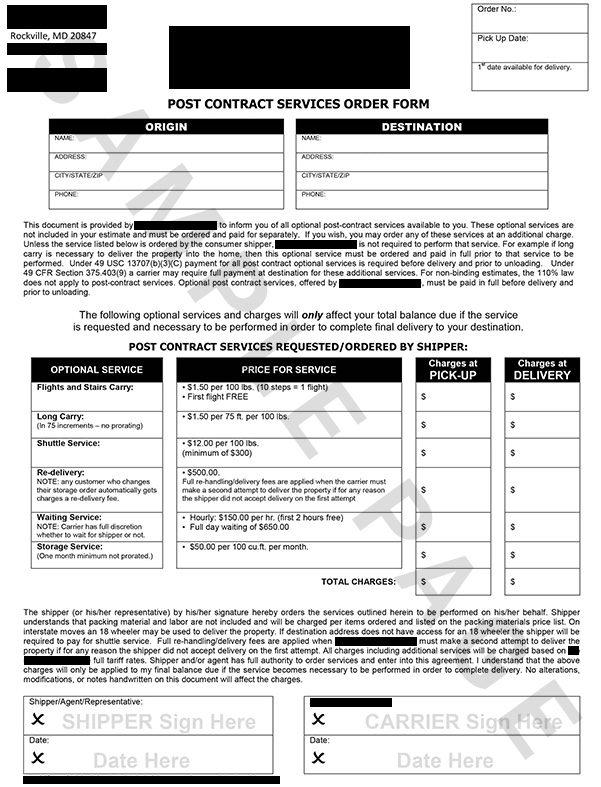What Do I Need To Know About All The Moving Paperwork?
ZIP MOVING & STORAGE CAN HELP YOU OUT!
Your information is essential to receive your moving quote.
YOUR EMAIL
*We respect your privacy, we don’t share your email with others.
VIEW QUOTE
Your phone number will help us provide you with the most accurate moving quote.
YOUR PHONE NUMBER
*We respect your privacy, we don't share your phone number.

One of our move consultants will reach out as soon as possible regarding your request.
Disclosure: Phone calls between you and us may be monitored and recorded. You agree that Zip Moving And Storage can make calls and/or send text messages to you at the telephone number associated with your account. Consent may be revoked at any time by calling 855-947-6543 or email info@zipmoving.us

Reading time: 13 minutes
Home » FAQs » Moving Paperwork » What Is Moving Paperwork?
Types of Moving Paperwork, Contracts and Documents
The process of moving, whether locally or long-distance, can be complicated. Choosing to employ a moving company will streamline the work of moving and keep the heavy lifting out of your hands. There are a few important moving paperwork, documents and forms to be aware of during your moving process.
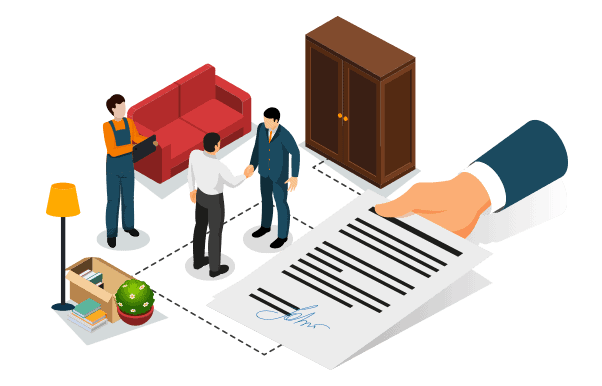
- Inventory Documentation
- Item Labeling and Counting
- Condition of Items
- Packing Materials Form
- Bill of Lading
- Hourly Based Charges
- Protection Plan Documentation
- Full Value Protection
- Waiver of Full Value Protection
- Rights and Responsibilities when you move and Ready to Move Pamphlet
- Inventory Documentation
- Item Labeling and Counting
- Condition of Items
- Packing Materials Form
- Bill of Lading
- Weight Based Charges
- Weight tickets
- Revised Written Estimate
- Protection Plan Documentation
- Full Value Protection
- Waiver of Full Value Protection
- Post Contract Service Order Form
- Long Carry
- Shuttle Service
- Elevator
- Re-delivery
- Waiting time
- Storage Service
- Stair carry
- Rights and Responsibilities for customers and Ready to Move Pamphlet
How To Read Moving Paperwork
Inventory
The purpose of the inventory list is to record all the items being moved, and the conditions of these items. Once this document is created it must be signed by the movers and the customer. Visit Inventory Documents for more detailed information.
Packing Materials Form
This is a very straightforward document. Packing materials form is used to document exactly what packing materials were used during your move. Please note, this DOES NOT include actual items packed. Check out Packing Materials Form for more detailed information.
Bill of Lading
By law, a Bill of Lading must be created and it serves as a document between the customer and the mover for the transportation of the customer’s goods.
Visit Bill of Lading for detailed information about Bill of Lading for local and long-distance moves.
Protection Plans
Protection Plans are offered by the moving company. Protection Plans offer compensation in a case of a loss or damage of the items. There are two protection plans:
- Full Value Protection
- Waiver of Full Value Protection
Visit Protection Plans Form for detailed information about Protection Plans for local and long-distance moves
Revised Written Estimate
If on the moving day you happen to have more things to move or pack, a revised written estimate takes place to record all the new items being moved. Read upon what happens in a case of revised written estimate here What is a revised written estimate?
Post Contract Service Order Form
This document states optional services that are not included in the initial estimate and are usually requested by the customer. Customers also pay separately for these services.
Click here to find out what exactly falls under these services.
Rights and Responsibilities
There’s nothing much to worry about here, make sure to read this section just to make sure you understand everything that’s in your contract fully. This document is valid until the completion of services.
Local Moving Paperwork
Inventory Documentation
The purpose of this document is to have a record of all items being moved and the condition of these items. This moving document is usually made during the loading process. The mover is obligated to also list damaged items. After the list is created, the customer and the mover MUST sign all the pages of the inventory.
Item Labeling and Counting
The movers will do a recount of the items before loading them onto the truck and label each item with a unique number sticker.
Condition of Items
Before loading, the movers will inspect and document the condition of each item in the “Condition at Origin” section.
For example:
| DESCRIPTIVE SYMBOLS | EXCEPTION SYMBOLS | LOCATION SYMBOLS |
| B/W – Black & White TV | BE – Bent | 1. Arm |
| C – Color TV | BR – Broken | 2. Bottom |
| CP – Carrier Packed | BU – Burned | 3. Corner |
| PBO – Packed by Owner | CH – Chipped | 4. Front |
| CD – Carrier Disassembled | CU – Contents & Condition Unknown | 5. Left |
| SW – Stretch Wrapped | D – Dented | 6. Legs |
| DBO – Disassembled by Owner | F – Faded | 7. Rear |
| PB – Professional Books | G – Gouged | 8. Right |
| PE – Professional Equipment | L – Loose | 9. Side |
| PP – Professional Papers | M – Marred | 10. Top |
| MCU – Mechanical Conditions Unknown | MI – Mildew | 11. Veneer |
| MO – Motheaten | 12. Edge | |
| P – Peeling | 13. Center | |
| R – Rubbed | 14. Inside | |
| RU – Rusted | 15. Drawer | |
| SC – Scratched | 16. Seat | |
| S – Stretched | 17. Door | |
| SH – Short | 18. Shelf | |
| SO – Soiled | 19. Hardware | |
| ST – Stained | ||
| T – Torn | ||
| W – Badly Worn | ||
| Z – Cracked |
Before this document is signed, double-check that all items being moved are listed and the damage is properly assessed. If a customer feels an assessment is incorrect, they must notify the mover before signing the document.
Packing Materials Form
The packing materials order form contains information describing the packing materials used during packing. The names of packing materials are not indicative of the items that are actually packed inside. For example, the book box is not used only for packing books, but rather a variety of items. The crating service/material does not refer to wooden crates but rather to cut cardboard. See our Types of Moving Boxes guide for more information.
This form states that unpacking is not included in the charges. The document also states that this service can be an additional purchase and that Zip Moving & Storage is authorized to use all necessary materials. All additional services will be charged based on the company’s rates and the customer will be notified about the final charges while in transit, prior to delivery.
Bill of Lading
As the law states, the moving company is required to prepare a Bill of Lading for the shipment. The Bill of Lading defines the contract between the customer and the moving company for the transportation of the customer’s items. The information about the shipment on this document has to be the same as the information on the order of service. The driver MUST provide a copy of this document on moving day (usually before loading the shipment).
It is very important not to lose or misplace your copy of this document.
Use a designated folder or binder to keep all documents on hand until the job is complete.
If the shipping of the items is performed under non-binding estimates, the Bill of Lading will not include the total charges.
Hourly Based Charges:
When moving locally, customers are billed hourly. More specifically, customers are billed for every fifteen minutes the movers are on the job. The hourly rate varies depending on how many movers are on the job and the day of the week. Customers will also be billed for the travel time (the time the movers spent traveling to and from the customer’s location). The complete list of information attached to the Bill of Lading can be found below.
The Bill of Lading MUST include these 14 elements:
- Mover’s name and address
- Name and address of any other moving company that might take part in the transportation of your items
- Name, address, and phone number of the office of the moving company to contact in case any additional information is needed
- Payment form accepted by the mover at delivery (same as in the estimate and order of service)
- Customer name, address, phone number, for collect-on-delivery basis transport
- Dates or period of time for pickup and delivery of the shipment (for non-guaranteed services)
- Dates for pickup and delivery and any penalty or entitlements stated in the agreement
- The actual date of pickup
- The ID number of vehicles used for transporting the shipment
- Terms and conditions for payment of the total charges and notice of any minimum charge
- For collect-on-delivery transport, the maximum amount your mover will demand from you at the time of delivery, based on the estimate
- Evidence of any insurance coverage
- Attachments to the Bill of Lading (binding/non-binding estimate, the order of service, inventory list)
- Two options for liability (Full Value Protection or Waiver of Full Value Protection)
One copy of this moving document MUST remain with the driver while the driver is in possession of the shipment as well during the loading of the shipment.
Protection Plan Documentation (Valuation Addendum Form)
There are two options for protection plans when it comes to liability.
Full Value Protection
Full Value Protection is the most comprehensive plan. The minimum level of liability for the shipment is $6.00 per pound multiplied by the weight of the shipment.
Waiver of Full Value Protection
Waiver of Full Value Protection carries minimal protection (released Value of 60 cents per pound per article). This protection is covered by the moving company as part of the agreement with the customer.
Another option is third party insurance. Zip Moving & Storage can provide options for third party insurance. The moving company is obligated to issue a policy or other written record of the purchase and provide a copy of the policy at the time of purchase.
Rights and Responsibilities booklet and Ready to Move Pamphlet
Customer responsibilities:
- Read all moving documents issued by the mover
- Be available and present at the time of pickup and delivery of the shipment
- Promptly notify the mover if something changes regarding the shipment (date, additional items)
- Make payments to the mover in the form previously agreed upon on and on time
- Promptly file claims with the mover in the event of loss, damage, or delays
Find more information on the official website of Federal Motor Carrier Safety Administration:
https://www.fmcsa.dot.gov/sites/fmcsa.dot.gov/files/docs/Rights-and-Responsibilities-2013.pdf
Long-distance Moving Paperwork
Inventory Documentation
The purpose of this document is to have a record of all items being moved and the condition of these items. This moving document is usually made during the loading process. The mover is obligated to also list damaged items. After the list is created, the customer and the mover MUST sign all the pages of the inventory.
Item Labeling and Counting
The movers will do a recount of the items before loading them onto the truck and label each item with a unique number sticker.
Condition of Items
Before loading, the movers will inspect and document the condition of each item in the “Condition at Origin” section.
Before this document is signed, double-check that all items being moved are listed and the damage is properly assessed. If a customer feels an assessment is incorrect, they must notify the mover before signing the document.
Packing Materials Order Form
The packing materials order form contains information describing the packing materials used during packing. The names of packing materials are not indicative of the items that are actually packed inside. For example, the book box is not used only for packing books, but rather a variety of items. The crating service/material does not refer to wooden crates but rather to cut cardboard. See our Types of Moving Boxes guide for more information.
This form states that unpacking is not included in the charges. The document also states that this service can be an additional purchase and that Zip Moving & Storage is authorized to use all necessary materials. All additional services will be charged based on the company’s rates and the customer will be notified about the final charges while in transit, prior to delivery.
As the law states, the moving company is required to prepare a Bill of Lading for the shipment. The Bill of Lading defines the moving contract between the customer and the moving company for the transportation of the customer’s items. The information about the shipment on this document has to be the same as the information on the order of service. The driver MUST provide a copy of this document on moving day (usually before or while loading the shipment).
It is very important not to lose or misplace your copy of this document.
Use a designated folder or binder to keep all documents on hand until the job is complete.
If the shipping of the items is performed under non-binding estimates, the Bill of Lading will not include the total charges.
The Bill of Lading MUST include these 14 elements:
- Mover’s name and address
- Name and address of any other moving company that might take part in the transportation of your items
- Name, address, and phone number of the office of the moving company to contact in case any additional information is needed
- Payment form accepted by the mover at delivery (same as in the estimate and order of service)
- Customer name, address, phone number, for collect-on-delivery basis transport
- Dates or period of time for pickup and delivery of the shipment (for non-guaranteed services)
- Dates for pickup and delivery and any penalty or entitlements stated in the agreement
- The actual date of pickup
- The ID number of vehicles used for transporting the shipment
- Terms and conditions for payment of the total charges and notice of any minimum charge
- For collect-on-delivery transport, the maximum amount your mover will demand from you at the time of delivery, based on the estimate
- Evidence of any insurance coverage
- Attachments to the Bill of Lading (binding/non-binding estimate, the order of service, inventory list)
- Two options for liability (Full Value Protection or Waiver of Full Value Protection)
One copy of this moving document MUST remain with the driver while the driver is in possession of the shipment as well during the loading of the shipment.
Weight Based Charges
The Bill of Lading for long-distance moves differs from the Bill of Lading for local moves because customers are not billed based on time, but rather based on the shipment weight. The Bill of Lading for long-distance moves has two additional attachments – the weight tickets and the revised written estimate. The mover is obligated to provide the customer with weight tickets, detailed in the next paragraph.
Weight Ticket
If the shipment is transported under a non-binding estimate, the moving company is obligated to provide the customer with weight tickets. Every time the shipment is weighed, a separate weight ticket MUST be obtained and signed by the weighmaster. If the shipment is weighed on the same scale, one ticket can be used for both weighings. There are six items that a weight ticket MUST contain:
- Name and location of the scale
- Date of each weighing
- ID’s of weight entries (tare, gross, net)
- Company ID of the vehicle
- Last name of the shipper as seen on the Bill of Lading
- Moving company’s shipment registration or Bill of Lading number
Revised Written Estimate
A revised written estimate is used if the customer adds additional items to the shipping inventory or requests additional packing on moving day. This revision may also be used if packing material or other additional services are needed that were not included in the original estimate. The revised written estimate replaces the original estimate and it MUST be signed before the packing and loading of the customer’s items.
If the moving company inspects the shipment and determines that there are many more items to be shipped than originally agreed upon, the moving company has the following options:
- Decide not to complete the move
- Ship only the items originally listed in the inventory
- Ship the additional items and not charge the customer extra
- Ship the additional items and charge the customer extra within 30 days
- Have the customer sign a revised written estimate that voids the original estimate. Payment may be requested before unloading at the delivery location
Protection Plan Documentation (Valuation Addendum Form)
There are two options for protection plans when it comes to liability.
Full Value Protection
Full Value Protection is the most comprehensive plan. The minimum level of liability for the shipment is $6.00 per pound multiplied by the weight of the shipment.
Waiver of Full Value Protection
Waiver of Full Value Protection carries minimal protection (released Value of 60 cents per pound per article). This protection is covered by the moving company as part of the agreement with the customer.
Another option is third party insurance. Zip Moving & Storage can provide options for third party insurance. The moving company is obligated to issue a policy or other written record of the purchase and provide a copy of the policy at the time of purchase.
Post Contract Service Order Form
These optional services are not included in the initial estimate and are usually requested by the customer. These services are also paid for separately.
Customers will be charged extra for long carries (if the movers carry items for a long distance between the truck and the customer’s home). This charge may be applied if there is no available parking for the moving truck.
Shuttle Service
If the need arises for the usage of shuttle services, customers will be additionally charged.
Elevators
If movers need to use an elevator, customers will be charged for elevator carry services.
Re-delivery
Customers are charged if the shipment is not able to be delivered on the scheduled date.
Waiting Time
Movers will wait up to two hours. After two hours, the customer is charged for each additional hour of waiting.
Storage Service
A storage service is charged when a shipment is not delivered on the scheduled date due to complications not disclosed with the movers.
Stair Carry
Customers are charged if the movers must carry the belongings up or down stairs. The stairs of a standard, two-floor family home do not result in a stair carry charge.
Rights and Responsibilities booklet and Ready to Move Pamphlet
Customer responsibilities:
- Read all moving documents issued by the mover
- Be available and present at the time of pickup and delivery of the shipment
- Promptly notify the mover if something changes regarding the shipment (date, additional items)
- Make payments to the mover in the form previously agreed upon on and on time
- Promptly file claims with the mover in the event of loss, damage, or delays
Find more information on the official website of Federal Motor Carrier Safety Administration:
https://www.fmcsa.dot.gov/sites/fmcsa.dot.gov/files/docs/Rights-and-Responsibilities-2013.pdf
